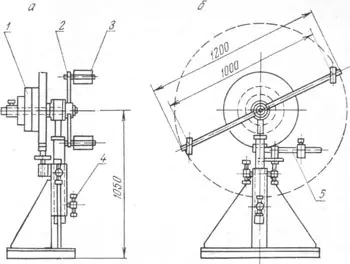We have already looked at this and this training devices for training swimmers... In this review, we will get acquainted with three more simulators designed to raise your swimming skills to a new qualitative level...
Content- Training device for swimmers.
- A training device for developing strength and practicing stroke movements in swimmers.
- Bench with expanders.
- Equipment diagrams for swimming pool halls.
Training device for swimmers.
The device is intended for training the muscles of the arms and shoulder girdle. Exercises for swimmers performed using the device match the movements of the athletes in the water, which allows them to increase the power of their strokes.
In the installation (Fig. 1, a), a lever 2 is mounted on an axis with a set of four wheels 1, along the edges of which there are pedals 3. The height of the axis 4 from the floor varies depending on the height of the swimmer. There is a calibrated braking device 5, which allows you to adjust the resistance in the range from 4 to 12 kg (Fig. 1, b).
The athlete, standing to the side of the wheel in a leaning forward position, places his hand on the pedal, then with a stroke, turns the wheel 180° and brings his hand forward, placing it on the second pedal to perform the next stroke. Note that the moment of inertia should be approximately equal to the athlete’s body weight, which is achieved by installing the required set of wheels.
A training device for developing strength and practicing stroke movements in swimmers.
The device is designed to teach and improve dry land swimming techniques. Basically, the device helps to purposefully develop the strength of the athlete's muscle groups and practice rowing movements with his hands, performing swimming exercises with additional load, the volume of which can be adjusted by the coach or the athlete himself.
The design of the device (Fig. 2, a) is as follows. The trolley 3 is installed on a standard gymnastic bench 4, one end of which lies on the crossbar of the gymnastic wall 1 at an angle of 5...20° to the horizontal, and the other rests on the floor. A nylon cord 2 is attached to the gymnastic wall. In Fig. 2, b shows the cart in three projections.
Bench with expanders.
The device is used to develop various muscle groups and practice arm movements in swimming in various ways.
In the installation (Fig. 3), a traction block device with weights 4 is placed on a welded horizontal frame 3. A cable is attached to it, which passes through block 1. The inclined bench is attached to the vertical frame 2.
Using the device you can perform the following exercises:- for developing arm muscles when swimming crawl;
- for developing arm muscles when swimming butterfly;
- for developing arm muscles when swimming on the back.
Equipment diagrams for swimming pool halls.
Specialized dry swimming halls are designed for warm-up and training sessions for special and general training of swimmers.
In Fig. Figure 4 shows a diagram of the arrangement of training devices in halls measuring 9X18, 12X24 and 10X18 m. Devices consisting of horizontal barbells are used, for example, to develop arm muscles (the athlete sits under the barbell and squeezes it), torso muscles (lifting the barbell with the shoulders or back behind counting flexion and extension of the torso and squats), leg muscles (in a lying position, press the barbell up with your legs), etc.
In Fig. 4, and a diagram of the hall equipment is given: 1 - universal simulator; 2— wall expanders; 3 — training carts; 4 — platforms for the barbell; 5 — simulator for hands; 6 — gymnastic walls.
In Fig. 4, b shows a diagram of the equipment of the Olympic swimming pool hall in Munich: 1 - stands for barbells; 2 - load located on two parallel horizontal rods; 3 — wall expanders; 4 — an inclined lounger with handles and hooks for support on the gymnastic wall; 5 — gymnastic wall; 6 - universal simulator; 7 - universal bench with soft top; 8 — platform for the barbell; 9 - load located on a horizontal rod moving along vertical guides; 10 — racks for dumbbells; 11 — racks for rods.
Post Views: 205


